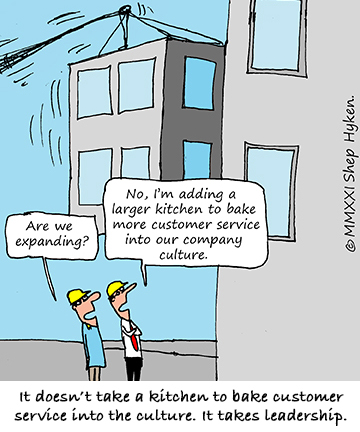I was recently interviewed by Yigal Adato for his mastermind group, all entrepreneurs and owners of pawnshops. We were discussing how important it is to “bake” customer service into the culture.

It’s leadership’s job to define the customer service vision, ensure it’s communicated, and be the role models demonstrating how customers and employees are to be treated.
In addition, leadership and management must defend the culture. If any part of the team isn’t in alignment with the customer service vision, be it an individual or a department – or even an entire region for larger companies – they need to be coached and properly trained. Everybody needs to be headed in the same direction and delivering a certain level of service to both internal and external customers. It’s not just in the culture, it’s a philosophy to be embraced by everyone in the organization.
And don’t think customers won’t notice. They will. And, when they talk to one person in your organization who is out of alignment, do you know what they think? They think everyone in the company is like that one person who isn’t delivering the typical experience you want your customers to experience.
At some point, Yigal said, “So, the culture is contagious.”
BOOM! That’s it! That is a great summary statement. In the best-run companies, the culture is contagious – for both the employees and the customers. Unfortunately, it’s also contagious in the worst-run companies.
It must be abundantly clear how you define customer service and experience in your organization. Everyone must know the role they play in delivering on that definition. To make it part of the culture, and to be contagious, it must be introduced during the hiring process, heavily trained in the onboarding of new employees, and consistently communicated and reinforced on a regular basis for sustainability.
The culture of your organization is what defines everything about your company. Think of some of the great recognizable brands and how they make you feel. Is it congruent with how employees act toward customers and each other? I remember the first time I stayed at a Hard Rock Hotel. I was excited to stay in this hip, cool, trendy hotel. Just like the restaurants have music memorabilia hanging on the walls, so do the hotels. I was fascinated by the environment. Rock music was piped in through the hotel. Employees walked around, bouncing to the beat of the music. Before long, I was doing it, too. Yes, their culture is contagious!
It’s simple, but that doesn’t mean it’s easy. The culture must be clearly defined. Employees must understand it. They must be trained to it. They must buy into it. They must live it. And they must love it. That’s how you begin to create a culture that is contagious.



